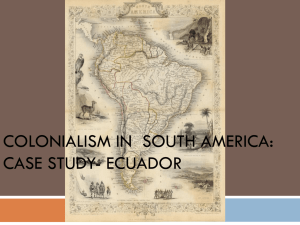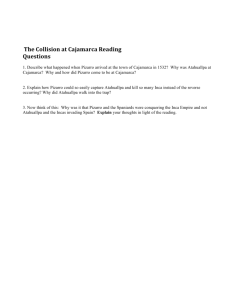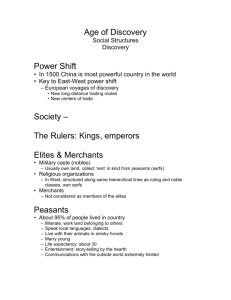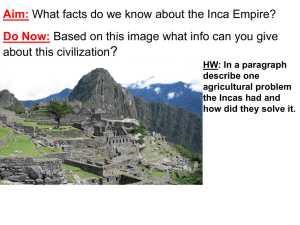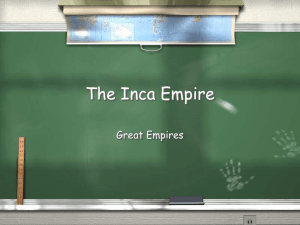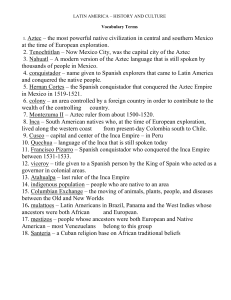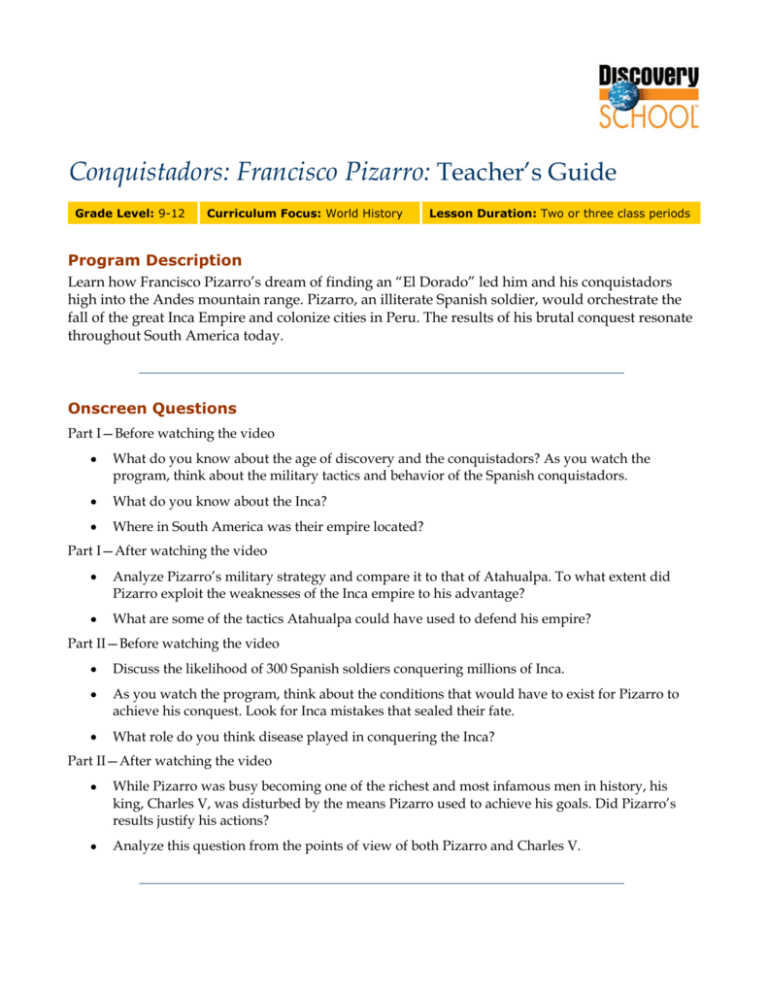
Conquistadors: Francisco Pizarro: Teacher’s Guide
Grade Level: 9-12
Curriculum Focus: World History
Lesson Duration: Two or three class periods
Program Description
Learn how Francisco Pizarro’s dream of finding an “El Dorado” led him and his conquistadors
high into the Andes mountain range. Pizarro, an illiterate Spanish soldier, would orchestrate the
fall of the great Inca Empire and colonize cities in Peru. The results of his brutal conquest resonate
throughout South America today.
Onscreen Questions
Part I—Before watching the video
•
What do you know about the age of discovery and the conquistadors? As you watch the
program, think about the military tactics and behavior of the Spanish conquistadors.
•
What do you know about the Inca?
•
Where in South America was their empire located?
Part I—After watching the video
•
Analyze Pizarro’s military strategy and compare it to that of Atahualpa. To what extent did
Pizarro exploit the weaknesses of the Inca empire to his advantage?
•
What are some of the tactics Atahualpa could have used to defend his empire?
Part II—Before watching the video
•
Discuss the likelihood of 300 Spanish soldiers conquering millions of Inca.
•
As you watch the program, think about the conditions that would have to exist for Pizarro to
achieve his conquest. Look for Inca mistakes that sealed their fate.
•
What role do you think disease played in conquering the Inca?
Part II—After watching the video
•
While Pizarro was busy becoming one of the richest and most infamous men in history, his
king, Charles V, was disturbed by the means Pizarro used to achieve his goals. Did Pizarro’s
results justify his actions?
•
Analyze this question from the points of view of both Pizarro and Charles V.
Conquistadors: Francisco Pizarro: Teacher’s Guide
2
Lesson Plan
Student Objectives
•
Determine the reasons for Francisco Pizarro’s success in vanquishing the Inca.
•
Write a paper explaining their conclusions.
Materials
•
Computer with Internet access
•
Paper and pencils
•
Print materials on Francisco Pizarro
Procedures
1. Hold a class discussion on some of the strategies Francisco Pizarro used to conquer the Inca.
Ask students to share their first impressions of the Inca culture and of Pizarro’s dealings with
the Inca people.
2. Encourage students to assist in making a class list of factors that contributed to Pizarro’s success
and the downfall of the Inca Empire. Help students conclude these facts:
•
Smallpox and other European diseases contributed significantly to diminishing the
population of the Inca Empire.
•
Pizarro’s cavalry had distinct advantages over Inca fighting techniques.
•
The Inca Empire experienced internal division.
3. Tell students they are going to research which of the three factors listed above played the
greatest role in the conquest of the Inca Empire, or whether all three were of equal importance.
Students will write a short paper explaining their answers. Students may work in small groups
or pairs or individually.
4. Students should use library materials and the Internet for their research. The following Web
sites may be helpful:
•
http://www.fll.vt.edu/culture-civ/spanish/texts/spainlatinamerica/pizarro.html
•
http://www.bruce.ruiz.net/PanamaHistory/francisco_pizarro.htm
•
http://www.ucalgary.ca/applied_history/tutor/eurvoya/inca.html
5. After students have completed their research and written their papers, have them share their
ideas with the class. What conclusions did most students reach about the reasons for Francisco
Pizarro’s successful conquest of the Inca?
6. If students have studied Hernán Cortés, ask them to compare Pizarro’s treatment of the Inca
with Cortés’s treatment of the Aztecs. Which conquistador showed more compassion to the
native peoples he encountered in the New World?
Published by Discovery Education. © 2005. All rights reserved.
Conquistadors: Francisco Pizarro: Teacher’s Guide
3
Assessment
Use the following three-point rubric to evaluate students’ work during this lesson.
•
3 points: Students actively participated in class discussions; researched the factors that
contributed to Pizarro’s successful conquest of the Inca Empire carefully and thoroughly
and wrote a well-organized, informative paper explaining their position; drew accurate
conclusions from their research.
•
2 points: Students participated somewhat in class discussions; researched the factors that
contributed to Pizarro’s successful conquest of the Inca Empire somewhat carefully and
thoughtfully and wrote a somewhat organized and informative paper explaining their
position; drew adequate conclusions from their research.
•
1 point: Students did not participate in class discussions; had difficulty effectively
researching the factors that contributed to Pizarro’s successful conquest of the Inca Empire
and wrote a poorly organized paper explaining their position; were unable to draw accurate
conclusions from their research.
Vocabulary
Atahualpa
Definition: The Inca emperor at the time of the Spanish conquest of the Inca Empire, in 1534
Context: Although the Inca raised 15,000,000 pesos of gold for the release of their ruler,
Atahualpa, Pizarro and his men executed him anyway.
conquistador
Definition: The Spanish word for conqueror; the term generally refers to the first Europeans to
enter a region of Latin America for the purpose of conquering the native peoples and settling in
the area
Context: Francisco Pizarro is considered one of the more ruthless conquistadors.
Inca
Definition: A South American Indian people who established one of the largest and wealthiest
empires in the Americas. At its height, the empire extended more than 2,500 miles along the
western coast of South America.
Context: Lack of unity in the Inca Empire made it possible for Pizarro to overtake the Inca army
and conquer the empire.
Francisco Pizarro
Definition: The Spanish conquistador who vanquished the Inca Empire in 1534
Context: Francisco Pizarro was determined and ruthless, willing to do just about anything to
defeat the Inca and conquer their empire.
Published by Discovery Education. © 2005. All rights reserved.
Conquistadors: Francisco Pizarro: Teacher’s Guide
4
Academic Standards
Mid-continent Research for Education and Learning (McREL)
McREL's Content Knowledge: A Compendium of Standards and Benchmarks for K-12 Education
addresses 14 content areas. To view the standards and benchmarks, visit link:
http://www.mcrel.org/compendium/browse.asp
This lesson plan addresses the following national standards:
•
Geography—Human Systems: Understands the forces of cooperation and conflict that shape
the divisions of Earth’s surface
•
History—World History: Understands the economic, political, and cultural interrelations
among peoples of Africa, Europe, and the Americas between 1500 and 1750
•
Language Arts—Writing: Uses the general skills and strategies of the writing process,
Gathers and uses information for research purposes
The National Council for the Social Studies (NCSS)
NCSS has developed national guidelines for teaching social studies. To become a member of NCSS,
or to view the standards online, go to http://www.socialstudies.org
This lesson plan addresses the following thematic standards:
•
Culture
•
Time, Continuity, and Change
•
Individuals, Groups, and Institutions
•
Power, Authority, and Governance
Support Materials
Develop custom worksheets, educational puzzles, online quizzes, and more with the free teaching tools
offered on the Discoveryschool.com Web site. Create and print support materials, or save them to a
Custom Classroom account for future use. To learn more, visit
•
http://school.discovery.com/teachingtools/teachingtools.html
Published by Discovery Education. © 2005. All rights reserved.




